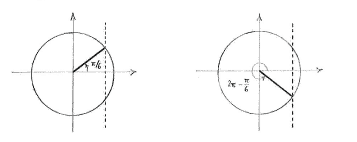Solution 4.4:3a
From Förberedande kurs i matematik 1
(Difference between revisions)
m |
|||
| (3 intermediate revisions not shown.) | |||
| Line 1: | Line 1: | ||
| - | + | The right-hand side of the equation is a constant, so the equation is in fact a normal trigonometric equation of the type <math>\cos x = a\,</math>. | |
| - | < | + | |
| - | + | ||
| - | [[ | + | In this case, we can see directly that one solution is <math>x = \pi/6\,</math>. Using the unit circle, it follows that <math>x = 2\pi - \pi/6 = 11\pi/6\,</math> is the only other solution between <math>0</math> and <math>2\pi\,</math>. |
| + | |||
| + | [[Image:4_4_3_a.gif|center]] | ||
| + | |||
| + | We obtain all solutions to the equation if we add multiples of <math>2\pi</math> to the two solutions above, | ||
| + | |||
| + | {{Displayed math||<math>x = \frac{\pi}{6} + 2n\pi\qquad\text{and}\qquad x = \frac{11\pi}{6} + 2n\pi\,,</math>}} | ||
| + | |||
| + | where ''n'' is an arbitrary integer. | ||
Current revision
The right-hand side of the equation is a constant, so the equation is in fact a normal trigonometric equation of the type \displaystyle \cos x = a\,.
In this case, we can see directly that one solution is \displaystyle x = \pi/6\,. Using the unit circle, it follows that \displaystyle x = 2\pi - \pi/6 = 11\pi/6\, is the only other solution between \displaystyle 0 and \displaystyle 2\pi\,.
We obtain all solutions to the equation if we add multiples of \displaystyle 2\pi to the two solutions above,
| \displaystyle x = \frac{\pi}{6} + 2n\pi\qquad\text{and}\qquad x = \frac{11\pi}{6} + 2n\pi\,, |
where n is an arbitrary integer.

